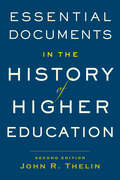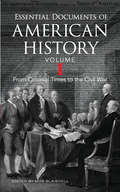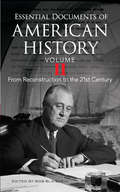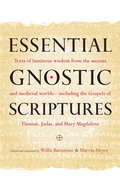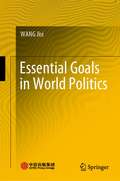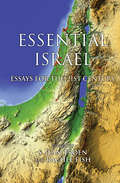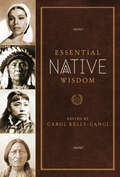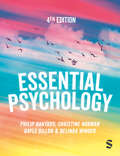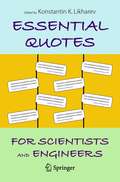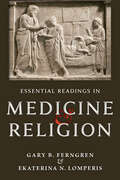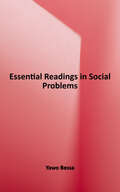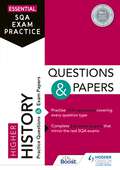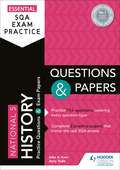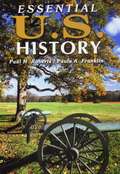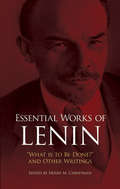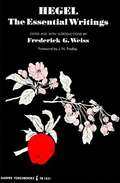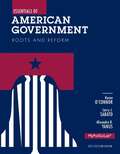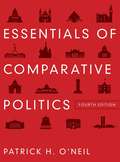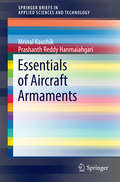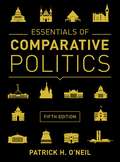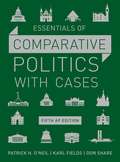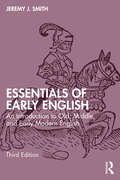- Table View
- List View
Essential Documents in the History of American Higher Education
by John R. ThelinThe thoroughly updated second edition of this dynamic and thoughtful collection focuses on the issues that have shaped American higher education in the past decade.Essential Documents in the History of American Higher Education, designed to be used alongside John R. Thelin's A History of American Higher Education or on its own, presents a rich collection of primary sources that chart the social, intellectual, political, and cultural history of American colleges and universities from the seventeenth century to the present. The documents are organized in sections that parallel the chapters in A History both chronologically and thematically, and sections are introduced with brief headnotes establishing the context for each source.This updated edition of Essential Documents focuses on the issues that have shaped American higher education in the past decade, from congressional investigations into endowments and court cases about paying student-athletes to accounts of campus protests over racial discrimination and adjuncts struggling in the "gig economy." From the successful fund-raising campaigns of 2014 to the closing of campuses because of the COVID-19 pandemic of 2020, the book also includes• a new tenth chapter, "Prominence and Problems: American Higher Education since 2010," and an updated introduction;• a number of landmark documents, including the charter for the College of Rhode Island (1764), the Morrill Land Grand Act (1862), the GI Bill (1944), and the Knight Commission Report on College Sports (2010); and • lively firsthand accounts by students and teachers that tell what it was like to be a Harvard student in the 1700s, to participate in the campus riots of the 1960s, to be a female college athlete in the 1970s, or to enroll at UCLA as an economically disadvantaged Latina in the 1990s.Thelin even stretches the usual bounds of documentary sources, incorporating popular pieces by Robert Benchley and James Thurber on their own college days as well as an excerpt from Groucho Marx's screwball film Horse Feathers. What emerges is a complex and nuanced collection that reflects the richness of more than three centuries of American higher education.
Essential Documents of American History, Volume I: From Colonial Times to the Civil War (Dover Thrift Editions)
by Bob BlaisdellThis compact volume offers a broad selection of the most important documents in American history: the Declaration of Independence, the Constitution, and the Emancipation Proclamation as well as presidential speeches, Supreme Court decisions, Acts and Declarations of Congress, essays, letters, and much more. The compilation of more than 150 documents, dating from 1606 to 1865, starts with the First Charter of Virginia, issued by King James I, and concludes with the abolition of slavery, as stated in the Thirteenth Amendment to the Constitution. Many of the selections recapture the voices of great Americans, from Powhatan's speech to Captain John Smith at Jamestown and the Pilgrims' Mayflower Compact to Benjamin Franklin's Plan of Union, Tecumseh's address to the Choctaws and Chickasaws, Frederick Douglass' "What to the Slave Is the Fourth of July?", and several orations by Abraham Lincoln. Brief introductions to each document place the works in historical context.
Essential Documents of American History, Volume II: From Reconstruction to the Twenty-first Century
by Bob BlaisdellThis compact volume offers a broad selection of the most important documents in American history: the Nineteenth Amendment to the Constitution, which ratified women's right to vote; the Supreme Court's decision on Brown v. Board of Education; and the "Heroism and Horror" portion of the 9/11 Commission Report; as well as presidential speeches, Acts and Declarations of Congress, essays, letters, and much more.The compilation of more than 70 documents opens with nineteenth-century speeches by Red Cloud ("The Great Spirit Made Us Both") and Chief Joseph ("I Will Fight No More Forever") and concludes with the election night speech by Senator Barack Obama on November 4, 2008. Many of the selections recapture the voices of great Americans, from Martin Luther King's "I Have a Dream" speech to Franklin D. Roosevelt's 1941 "The Four Freedoms" State of the Union Message, the Apollo 11 astronaut narratives from the moon, and addresses by Susan B. Anthony, John Muir, Margaret Sanger, William Jennings Bryan, and many others. Brief introductions to each document place the works in historical context.
Essential Gnostic Scriptures
by Willis Barnstone Marvin MeyerThe people we've come to call gnostics were passionate advocates of the view that salvation comes through knowledge and personal experience, and their passion shines through in the remarkable body of writings they produced over a period of more than a millennium and a half. Willis Barnstone and Marvin Meyer have created a translation that brings the gnostic voices to us from across the centuries with remarkable power and beauty--beginning with texts from the earliest years of Christianity--including material from the Nag Hammadi library--and continuing all the way up to expressions of gnostic wisdom found within Islam and in the Cathar movement of the Middle Ages. The twenty-one texts included here serve as a compact introduction to Gnosticism and its principal ideas--and they also provide an entrée to the pleasures of gnostic literature in general, representing, as they do, the greatest masterpieces of that tradition.
Essential Goals in World Politics
by Jisi WangThis book presents a unique effort to apply political philosophy to realities of the world. Among numerous objectives that states, politicians, and individuals try to reach, some are vague, like power, interest, and happiness. Some others, like democracy, order, and rule of law, are ways and means to serve more fundamental purposes. While national reunification is seen as prerequisite on the political agenda of the People’s Republic of China and both South and North Koreas, and religious purity is regarded as essential to many Muslim communities, these are not universally accepted principal goals in the world. The author identifies and defines security, wealth, faith, justice, and freedom as five ultimate goals in world politics and explains why they are central. Without jargons and using many cases in China and other countries, the author illustrates that different countries at different times have varied priorities in their national politics, but they must provide security, sustain economic growth, set up a value system, maintain social justice, and secure personal freedom for their citizens. Although the world today has been relatively peaceful and accumulated much more wealth as compared to the past centuries, vacuums of faith and morality, conflicting beliefs, and lack of social justice are threatening mankind. In theory, the five ultimate goals should be reached simultaneously and reinforce each other. However, in practice they are often in contradiction. For example, national security might be strengthened at the expense of prosperity, and industrialization for economic growth has sacrificed nontraditional security interests such as the environment. The accumulation of wealth often results in its unequal distribution and grievances about injustice, and freedom and equality are regarded by some political thinkers as “natural enemies” to each other. A virtuous state should be able to reach all the five goals, while a bad state may not have even one of them. Looking around the world today, Denmark in Europe and Japan in Asia are closer to a virtuous state than most other countries despite their own deficiencies, but they are generally homogeneous in terms of ethnicity and culture. Singapore, with its ethnic diversity, has to limit freedom to obtain other goals. This book compares the development paths of China, the United States, and some other countries to demonstrate their advantages and disadvantages in becoming a better polity.
Essential Israel: Essays for the 21st Century (Perspectives on Israel Studies)
by Gil Troy Michael Brenner David Ellenson Maoz Azaryahu Alan Dowty Donna Robinson Divine Yaakov Ariel Rachel S. Harris Ranen Omer-Sherman David Makovsky Arnon Golan Yedidia Stern Steven Bayme Norman Stillman&“An excellent tool in Middle Eastern politics classes [and] an intellectual resource for experts who want to learn more about the complexities of Israel.&”—Reading Religion Americans debate constantly about Israel, its place in the Middle East, and its relations with the United States. Essential Israel examines a wide variety of complex issues and current concerns in historical and contemporary contexts to provide readers with an intimate sense of the dynamic society and culture that is Israel today, providing a broader and deeper understanding to inform the conversation. The expert contributors to this volume address the Arab-Israeli conflict, the state of diplomatic efforts to bring about peace, Zionism and the impact of the Holocaust, the status of the Jewish state and Israeli democracy, foreign relations, immigration and Israeli identity, as well as literature, film, and the other arts. This unique and innovative volume provides solid grounding to understandings of Israel&’s history, politics, culture, and possibilities for the future.
Essential Native Wisdom (Essential Wisdom)
by Carol Kelly-GangiQuotations from Sitting Bull, Wilma Mankiller, N. Scott Momaday, and many more.Essential Native Wisdom gathers hundreds of powerful quotations from an extraordinary group of people from the mid-1700s to the present day. There are excerpts from political and spiritual leaders; writers and poets; activists and artists; warriors and statesmen; scholars and historians; actors and athletes; and musicians and orators. It’s a wide-ranging collection that is enlightening and engaging—and provides a testament to the spirit of strength, endurance, and hope. Sitting Bull eloquently reveals the devastating hardship his people endured at the hands of the white leaders who sought to destroy their way of lifeWinona LaDuke vividly recalls traditions from her people, passed down from generation to generationElizabeth Peratrovich speaks passionately about the freedoms that are guaranteed to Native people under the Bill of Rights, and more
Essential Psychology
by Philip Banyard Christine Norman Gayle Dillon Belinda WinderEssential Psychology provides a thorough and accessible introduction to the field of psychology. Written by a team of expert authors, this book warmly welcomes you to all the areas covered on British Psychological Society accredited degree courses. It includes chapters focused on evolution, memory, thinking and reasoning, motivation and emotion, development, and personality. New to this Fourth Edition are two chapters which focus on racism in psychology and LGBTQ+ psychology. It applies psychological theory to the real world, and includes a wealth of learning features to support your learning, including critical reflections and discussion questions that nurture creative thinking beyond the syllabus. This is the ideal introductory textbook for undergraduate students of psychology and those undertaking a Master′s conversion course in psychology.
Essential Psychology
by Philip Banyard Christine Norman Gayle Dillon Belinda WinderEssential Psychology provides a thorough and accessible introduction to the field of psychology. Written by a team of expert authors, this book warmly welcomes you to all the areas covered on British Psychological Society accredited degree courses. It includes chapters focused on evolution, memory, thinking and reasoning, motivation and emotion, development, and personality. New to this Fourth Edition are two chapters which focus on racism in psychology and LGBTQ+ psychology. It applies psychological theory to the real world, and includes a wealth of learning features to support your learning, including critical reflections and discussion questions that nurture creative thinking beyond the syllabus. This is the ideal introductory textbook for undergraduate students of psychology and those undertaking a Master′s conversion course in psychology.
Essential Quotes for Scientists and Engineers
by Konstantin K. LikharevThis book brings together about 2,500 quotations on various topics of interest to scientists and engineers, including students of STEM disciplines. Careful curation of the material by the editor provides the reader with far greater value than can be obtained by searching the internet.The quotes have been selected for various attributes including: importance of topic, depth of insight, and - not least - wit, with many of them satisfying all these criteria. To make sequential reading of the quotes more engaging, they are grouped into broad topical sections, and the entries within each section are organized thematically, forming quasi-continuous narrative threads. The text and authorship of each quote have been carefully verified, and the most popular cases of misquotation and misattribution are noted. The book represents a valuable resource for those writing science and engineering articles as well as being a joy to read in its own right.
Essential Readings in Medicine & Religion
by Gary B. Ferngren Ekaterina N. Lomperis“[A] useful, well-edited anthology of important texts in the history of the intersection of religion and medicine.” —Warren Kinghorn, MD, ThD, Duke University Medical Center and Duke Divinity SchoolGary B. Ferngren and Ekaterina N. Lomperis have gathered a rich collection of annotated primary sources that illustrate the intersection of medicine and religion. Intended as a companion volume to Ferngren’s classic Medicine and Religion, which traces the history of the relationship of medicine to religion in the Western world from the earliest ancient Near Eastern societies to the twenty-first century, this useful and extensive sourcebook places each key document in historical context.Drawing from more than 160 texts, the book explores a number of themes, including concepts of health, the causes and cure of disease, medical ethics, theodicy, beneficence, religious healing, consolation, and death and dying. Each chapter begins with an introduction that furnishes a basic historical setting for the period covered. Modern translations, some of which have been made especially for this volume, are used whenever possible. The texts are numbered sequentially within each chapter and preceded by a short introduction to both the author and the subject.Touching on Mesopotamia, Egypt, Israel, Greece, Rome, the European Middle Ages, Islam, early modern Europe, and the modern era, Essential Readings in Medicine and Religion brings a wide range of sources together to expand on the crucial lessons of Medicine and Religion. This book is a useful introduction for all students of history, divinity, medicine, and health.
Essential Readings in Medicine and Religion
by Gary B. Ferngren Ekaterina N. LomperisAn indispensible collection of sources chronicling the relationship between medicine and religion from ancient to modern times.Gary B. Ferngren and Ekaterina N. Lomperis have gathered a rich collection of annotated primary sources that illustrate the intersection of medicine and religion. Intended as a companion volume to Ferngren’s classic Medicine and Religion, which traces the history of the relationship of medicine to religion in the Western world from the earliest ancient Near Eastern societies to the twenty-first century, this useful and extensive sourcebook places each key document in historical context.Drawing from more than 160 texts, the book explores a number of themes, including concepts of health, the causes and cure of disease, medical ethics, theodicy, beneficence, religious healing, consolation, and death and dying. Each chapter begins with an introduction that furnishes a basic historical setting for the period covered. Modern translations, some of which have been made especially for this volume, are used whenever possible. The texts are numbered sequentially within each chapter and preceded by a short introduction to both the author and the subject.Touching on Mesopotamia, Egypt, Israel, Greece, Rome, the European Middle Ages, Islam, early modern Europe, and the modern era, Essential Readings in Medicine and Religion brings a wide range of sources together to expand on the crucial lessons of Medicine and Religion. This book is a useful introduction for all students of history, divinity, medicine, and health.
Essential Readings in Social Problems
by Yawo BessaThis book provides students with a collection of engaging and thought-provoking articles that deepen their understanding of the topics and themes discussed within courses that address social issues. The anthology is organized into six distinct units. The opening unit introduces readers to the concept of the sociological imagination, which allows individuals to make connections between social structures and individual conditions to formulate social theories. In Unit 2, the readings examine the destructive nature of inequality, causes of poverty, issues related to gender inequality, and more. Unit 3 focuses on the concept of deviance and how it applies to sexuality and crime. Units 4 and 5 explore the relationship between race, ethnicity, white privilege, and social problems, and the intersection of human health and environmental problems. Dedicated readings address the social construction of race, biodiversity, and more. Unit 6, the final unit, offers readers a variety of proposed solutions for social problems with an emphasis on social movements to combat economic inequality, increasing authoritarianism, and ecological crises. Designed to stimulate critical thought, Essential Readings in Social Problems is an ideal supplementary text for courses in sociology and any other course that explores social challenges.
Essential SQA Exam Practice: From the publisher of How to Pass
by Hodder GibsonExam board: SQALevel: HigherSubject: HistoryFirst teaching: September 2018First exam: Summer 2019Practice makes permanent. Feel confident and prepared for the SQA Higher History exam with this two-in-one book, containing practice questions for every question type and the most popular topics, plus two practice papers.- Choose to revise by question type or topic: A simple grid enables you to pick particular question styles or course areas that you want to focus on, with answers provided at the back of the book- Understand what the examiner is looking for: Clear guidance on how to answer each question type is followed by plenty of questions so you can put the advice into practice, building essential exam skills- Remember more in your exam: Repeated and extended practice will give you a secure knowledge of the key developments in British, European, world and Scottish history- Familiarise yourself with the exam papers: Both practice papers mirror the language and layout of the real SQA papers; complete them in timed, exam-style conditions to increase your confidence before the exams- Find out how to achieve a better grade: Answers to the practice papers have commentaries for each question, with tips on writing successful answers and avoiding common mistakesFully up to date with SQA's requirementsThe questions, mark schemes and guidance in this practice book match the requirements of the revised SQA Higher History specification for examination from 2019 onwards.This book covers the following topics:The British, European and world paper, Section 1: British:- Church, State and Feudal Society, 1066-1406- The Century of Revolutions, 1603-1702- The Atlantic Slave Trade- Britain, 1851-1951- Britain and Ireland, 1900-1985The British, European and world paper, Section 2 - European and World:- The Crusades, 1071-1204- The American Revolution, 1763-1787- The French Revolution, to 1799- Germany, 1815-1939- Italy, 1815-1939- Russia, 1881-1921- USA, 1918-1968- Appeasement and the Road to War, to 1939- The Cold War, 1945-1989The Scottish Paper:- The Wars of Independence, 1249-1328- The Age of the Reformation, 1542-1603- The Treaty of Union, 1689-1740- Migration and Empire, 1830-1939- The Impact of the Great War, 1914-1928
Essential SQA Exam Practice: From the publisher of How to Pass
by John Kerr Jerry TealeExam board: SQALevel: National 5Subject: HistoryFirst teaching: September 2017First exam: Summer 2018Practice makes permanent. Feel confident and prepared for the SQA National 5 History exam with this two-in-one book, containing practice questions for every question type and the most popular topics, plus two full practice papers - all written by experienced examiners.- Choose to revise by question type or topic: A simple grid enables you to pick particular question styles or course areas that you want to focus on, with answers provided at the back of the book- Understand what the examiner is looking for: Clear guidance on how to answer each question type is followed by plenty of questions so you can put the advice into practice, building essential exam skills- Remember more in your exam: Repeated and extended practice will give you a secure knowledge of the key developments in Scottish, British, European and World history- Familiarise yourself with the exam paper: Both practice papers mirror the language and layout of the real SQA papers; complete them in timed, exam-style conditions to increase your confidence before the exams- Find out how to achieve a better grade: Answers to the practice papers have commentaries for each question, with tips on writing successful answers and avoiding common mistakesFully up to date with SQA's requirementsThe questions, mark schemes and guidance in this practice book match the requirements of the revised SQA National 5 History specification for examination from 2018 onwards.This book covers the following topics:Section 1: Scottish contexts:- The Wars of Independence, 1286-1328- Mary Queen of Scots and the Reformation, 1542-1587- Migration and Empire, 1830-1939- The Era of the Great War, 1900-1928Section 2: British contexts:- The Atlantic Slave Trade, 1770-1807 - Changing Britain, 1760-1914 - The Making of Modern Britain, 1880-1951 Section 3: European and World contexts:- Hitler and Nazi Germany, 1919-1939 - Red Flag: Lenin and the Russian Revolution, 1894-1921 - Free at Last? Civil Rights in the USA, 1918-1968 - Appeasement and the Road to War, 1918-1939 - World War II, 1939-1945 - The Cold War, 1945-1989
Essential U. S. History
by Lillian Forman Paul M. Roberts Paula A. Franklin Gerard J. PelissonThis text is designed for a one-year United States history course for adults studying on the high school level and for regular day high school students. Essential U.S. History focuses on the history of the United States (including the land and its people before it became the United States). Its coverage begins with a study of major groups of Native-American culture and comes up to the mid-term elections of 2006. Following the curricula of many states, this fully illustrated book is organized chronologically but with separate regional emphasis within each time period. The text prepares students taking a high school United States history course by giving them high-interest but comprehensive coverage of key events and themes in American history. The book's sophisticated presentation works especially well with adult education students. However, it has been written and designed to facilitate instruction in any U.S. history classroom.
Essential Works of Lenin: "What Is to Be Done?" and Other Writings
by Vladimir Ilyich LeninAmong the most influential political and social forces of the twentieth century, modern communism rests firmly on philosophical, political, and economic underpinnings developed by Vladimir Ilyich Ulyanov, later known as Lenin. In this volume, comprising the four works generally considered his most important publications, Lenin presents the goals and tactics of Communism with remarkable directness and forcefulness.His first major work was The Development of Capitalism in Russia, written in prison after Lenin had been arrested for anti-government activities in 1895. Represented here by key sections, the book developed a number of crucial concepts, including the significance of the industrial proletariat as a revolutionary base. What Is to Be Done?, long regarded as the key manual of Communist action, is presented complete, containing Lenin's famous dissection of the Western idea of the political party along with his own concept of a monolithic party organization devoted to achieving the goal of dictatorship of the proletariat. Also presented complete is Imperialism, the Highest Stage of Capitalism, in which Lenin examines the final "parasitic" stage of capitalism. Finally, this volume includes the complete text of The State and Revolution, Lenin's most significant work, in which he totally rejects the institutions of Western democracy and presents his vision of the final perfection of Communism.For anyone who seeks to understand the twentieth century, capitalism, the Russian revolution, and the role of Communism in the tumultuous political and social movements that have shaped the modern world, the essential works of Lenin offer unparalleled insight and understanding. Taken together, they represent a balanced cross-section of this revolutionary theories of history, politics, and economics; his tactics for securing and retaining power; and his vision of a new social and economic order.
Essential World History
by Henry Brun Margaret FransonThis text is designed to provide students with a readable and enjoyable discovery of the development of civilizations and cultures in Asia, Africa, Europe, the Middle East, and the Americas.
Essential Writings
by Georg Wilhelm Friedrich Hegel Frederick G. WeissHegel's essential writings on all aspects of philosophy
Essentials Of American Government: Roots And Reform, 2012 Election Edition
by Larry J. Sabato Karen J. O'Connor Alixandra B. YanusEssentials of American Government: Roots and Reform, 2012 Election Edition explores how the origins of American government affect the issues facing the United States today. This streamlined and flexible text offers the strongest coverage of history and current events. This approach encourages students to study present political structures and behaviors in full constitutional and historical context. The text helps students learn how our government evolved and how they can become more informed citizens. Most importantly, it encourages them to discover that politics can be-and most often is-a good thing. This text features full integration with the New MyPoliSciLab. MyPoliSciLab includes a wide array of resources to encourage students to look at American politics like a political scientist and analyze current political issues. Political Explorer lets students play the role of a political scientist by investigating issues through interactive data. Core Concept videos discuss the big ideas in each chapter and apply them to key political issues. Simulations allow students to experience how political leaders make decisions. A better teaching and learning experience This program provides a better teaching and learning experience-for you and your students. Here's how: Personalize Learning-The New MyPoliSciLab delivers proven results in helping students succeed, provides engaging experiences that personalize learning, and comes from a trusted partner with educational expertise and a deep commitment to helping students and instructors achieve their goals. MyPoliSciLab is now compatible with BlackBoard! Engage Students-The stunning visual design engages students in the text. Improve Critical Thinking- Learning objectives in every chapter help students focus on important topics. Analyze Current Events-Coverage of the 2012 elections keeps the study of politics relevant and shows how political scientists look at the development of the American political system. Support Instructors-A full supplements package including the Class Preparation Tool in the New MyPoliSciLab is available. Note: This is a standalone book if you want the book/access card order the ISBN below: 0205950019 / 9780205950010 Essentials of American Government: Roots and Reform Plus MyPolisciLab with Pearson eText, 2012 Election Edition Package consists of: 0205883990 / 9780205883998 Essentials of American Government: Roots and Reform, 2012 Election Edition 0205949975 / 9780205949977 NEW MyPoliSciLab with Pearson eText -- Valuepack Access Card
Essentials Of Comparative Politics (Fourth Edition)
by Patrick H. O'NeilEssentials of Comparative Politics introduces students to the concepts that political scientists use to study and compare political systems and the particulars of specific political systems. The Fourth Edition has been revised and updated to include the most current and relevant examples and scholarship. The text is available with a corresponding casebook of 13 country studies and a corresponding reader; the three components can be used individually or in any combination.
Essentials of Aircraft Armaments
by Mrinal Kaushik Prashanth Reddy HanmaiahgariThis book aims to provide a complete exposure about armaments from their design to launch from the combat aircraft. The book details modern ammunition and their tactical roles in warfare. The proposed book discusses aerodynamics, propulsion, structural as well as navigation, control, and guidance of aircraft armament. It also introduces the various types of ammunition developed by different countries and their changing trends. The book imparts knowledge in the field of design, and development of aircraft armaments to aerospace engineers and covers the role of the United Nations in peacekeeping and disarmament. The book will be very useful to researchers, students, and professionals working in design and manufacturing of aircraft armaments. The book will also serve air force and naval aspirants, and those interested in working on defence research and developments organizations.
Essentials of Comparative Politics
by Patrick H. O'NeilThe Essentials of Comparative Politics family provides all of the tools professors need to introduce the study and comparison of political systems. A brief conceptual textbook of the core ideas behind comparative politics, a complete casebook of thirteen country studies, and a comprehensive reader of secondary and primary sources.
Essentials of Comparative Politics with Cases Fifth AP Edition
by Don Share Patrick H. O'Neil Karl FieldsThis textbook is meant to contribute to our understanding of comparative politics (the study of domestic politics around the world) by investigating the central ideas and questions that make up this field. It begins with the most basic struggle in politics--the battle between freedom and equality and the task of reconciling or balancing these ideals. How this struggle has unfolded across place and time represents the core of comparative politics. The text continues by emphasizing the importance of institutions. Human action is fundamentally guided by the institutions that people construct, such as culture, constitutions, and property rights. Once established, these institutions are both influential and persistent--not easily overcome, changed, or removed. How these institutions emerge, and how they affect politics, is central to this work.
Essentials of Early English: An Introduction to Old, Middle, and Early Modern English
by Jeremy J. SmithThe third edition of this successful textbook has been fully revised and updated. Essentials of Early English is a practical and highly accessible introduction to the early stages of the English language: Old English, Middle English, and Early Modern English. Designed specifically as a handbook for students beginning the study of Early English language, whether for linguistic or literary purposes, it presumes little or no prior knowledge of the history of English. Features of this new edition include: Comprehensive updating of the contents to take account of new developments in the subject Newly added sample texts and accompanying notes Links to images of many of the illustrative texts An updated annotated bibliography. A contextual introduction of the history of English is provided, which includes an outline of English in relation to its origins. A deeper analysis is then given on each of the key stages of Early English, using the language of King Alfred, Chaucer, and Shakespeare respectively to illustrate points. Thus, the essential characteristics of each stage of the language are provided to create the ideal course book for History of English courses and to give the student a firm foundation of basic linguistic knowledge which can be applied to further study.
